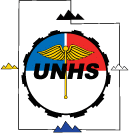UNHS News & Events
Navajo Nation health care workers develop innovations to control the spread of COVID-19
- By unhsinc
- September 14, 2020
- No Comments
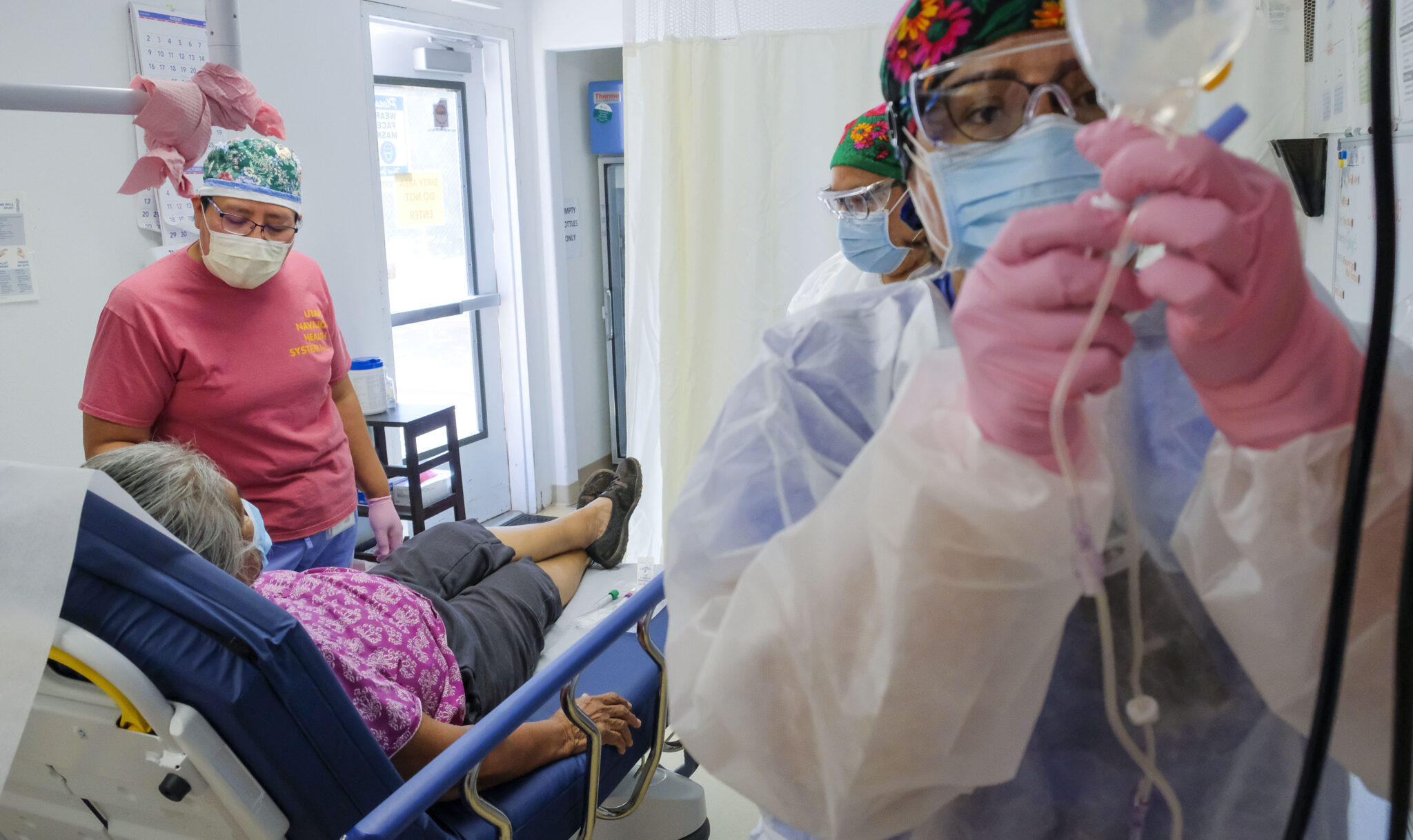
Southern San Juan County • If a patient is tested for the coronavirus on a Friday at the Navajo Mountain Community Health Center, Roxanna Yazzie works late.
Yazzie, the clinic’s lab technician, will finish up her usual duties around 3:30 p.m., pack the nasal swabs into a cooler and take off for the San Juan County Public Health building in Blanding. The circuitous drive through Arizona is 185 miles one-way, and Yazzie usually doesn’t get home until 11 p.m.
From Blanding, the used test kits are transported by a courier to a lab near Salt Lake City, and results are typically returned to patients within four days, a wait time that matches the national average.
The patchwork transport system is one of many innovations health care workers for the Utah Navajo Health System (UNHS) have developed during the coronavirus pandemic with everyone from clinic managers to housekeepers to lab techs like Yazzie pitching in to help with transport, depending on the day of the week.
UNHS manages four rural clinics in southern San Juan County, the most remote of which is in Navajo Mountain. Nestled between its namesake mountain and Lake Powell, the community of Naatsisʼáán, as it’s called in Navajo, is surrounded by some of the most rugged — and beautiful — geography on the Colorado Plateau.
When the clinic calls in an ambulance, it can take an hour to arrive. A helicopter is the fastest option for patients in critical condition, but it’s typical to wait 30 minutes before one lands on the basketball court outside the clinic, a cluster of modified double-wides. Staffers participating in radiology training commute over eight hours to Ogden on Mondays, sometimes braving all-night drives through rain or snowstorms to make it back to work on Tuesday morning.
Due to Navajo Mountain’s geographic isolation, many of the roughly 500 residents in the tribal chapter felt February reports that a deadly new virus had arrived on the East and West coasts of the United States were a distant problem. But that sense of security didn’t last long.
By the end of March, Navajo Mountain was one of Utah’s coronavirus hot spots.
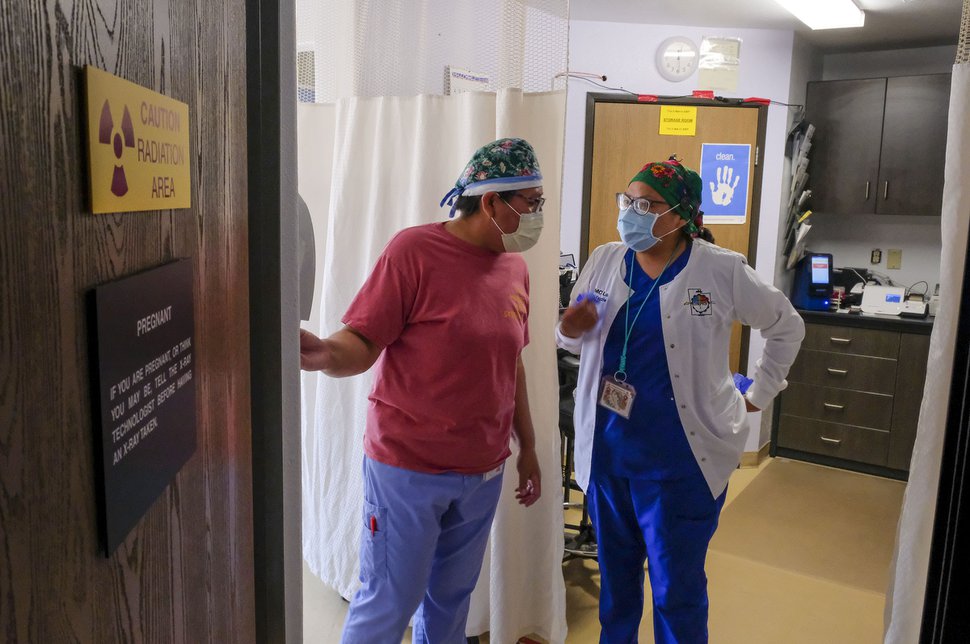
“Chinchilbeto [Ariz.] had a [religious] revival,” Navajo Mountain clinic manager Revina Talker said of the first documented spread of the coronavirus on the Navajo Nation in March. “A week later, the same people that went to that first revival came to a revival here in Navajo Mountain. … A bunch of elderly people went to that revival and got COVID.”
Two Utah residents, a grandmother and her son, died in March, the first COVID-19 deaths in San Juan County (though they took weeks to be reported in the official numbers due to a lack of street addresses in the region). And in the months that followed, the full-time health care workers at Navajo Mountain — all Diné women — had to quickly adjust to the new reality. Talker had to balance keeping her staff safe and responding to the outbreak in the community.
“My thought was, ‘I can’t get one staff [member] sick because if we do, we have to shut the whole clinic down,’” Talker recalled. All nonessential and dental appointments were delayed, and a tent was set up outside the clinic to test, and treat patients with COVID-19 symptoms.
In June, a staff member did test positive and the entire clinic was closed for two weeks. UNHS paid for the staff to quarantine in a hotel in Blanding, and nobody else contracted the disease.
Working through the pandemic in a small community can bring burdens not found at a larger urban hospital.
“Growing up here, we all pretty much knew each other,” said Sonya Sloan, a 33-year-old medical assistant. “It’s one of those things where you know where everybody lives. You know who is related. It’s like one big old family.”
Sloan went to Glendale Community College in Arizona on a full-ride volleyball scholarship with the goal of entering the medical profession and finished her schooling at Carrington College. She worked with medical providers who delivered infants in Phoenix for two years but kept an eye out for job openings back home in Navajo Mountain.
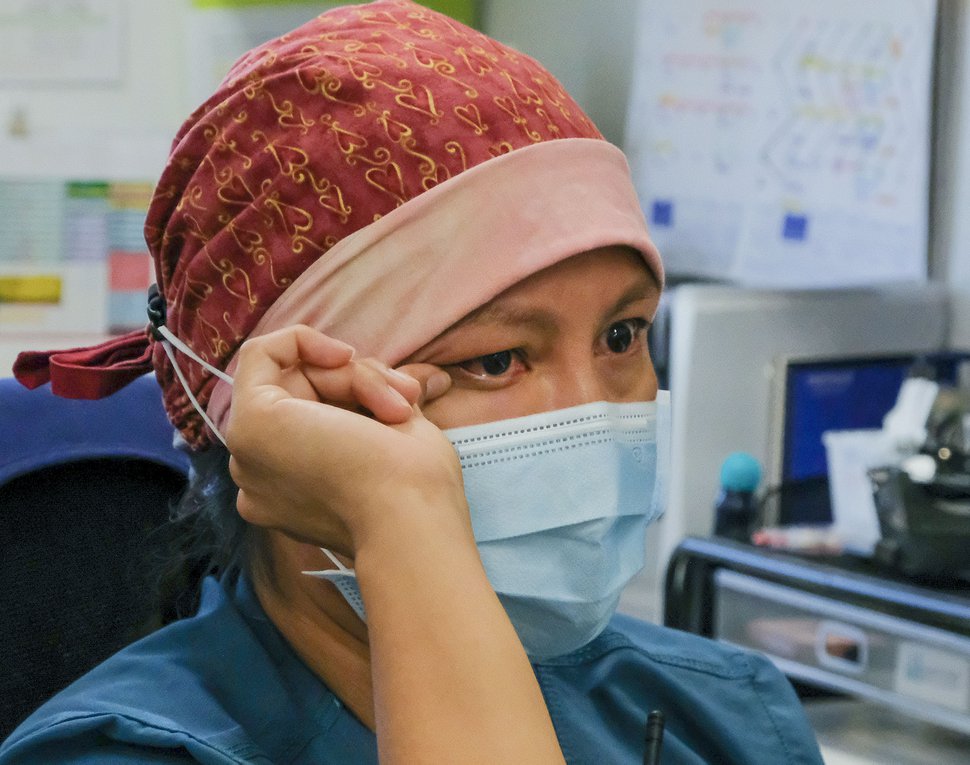
“Ever since I was a kid,” she said, “I always wanted to come back and help my family — help my people out.”
When a front desk position was advertised in 2012, Sloan jumped at the opportunity and has been at the clinic ever since. But the same community bonds that brought her back home have added stress during the pandemic.
“Because I know everybody, [deaths in the community] really take a toll on me,” said Sloan, who has lost relatives to COVD-19.
Before March, she was living with her mother and her 84-year-old grandmother in close quarters, but Sloan bought a travel trailer in the spring so she could keep socially distant from more vulnerable family members.
“I pretty much stay there,” she said. “I think I’m the strictest one in the family. I always tell them, ‘It only takes one.’”
Monument Valley
Amanda Begay, a licensed practical nurse at UNHS’ clinic in Monument Valley, 110 miles from Navajo Mountain, said that the severity of the pandemic on the Utah Navajo strip also took her and her colleagues by surprise.
“As Navajo people, we thought that it wouldn’t happen here, it wouldn’t hit here,” she said, “but it seems we got hit here the hardest because of our living conditions as far as living without running water and electricity and being sometimes in multigenerational homes.”
The coronavirus tore through the Navajo Nation early in the spring. As of Friday, it had killed 527 people on the 174,000-person reservation, a higher death toll than all of Utah, which has a population of 3.2 million. But, thanks to an aggressive response from the Navajo Nation government and a testing rate higher than most states, cases likely peaked in late April.
“Now we see the other side where it’s not as bad,” Begay said. “I think our Navajo Nation President [Jonathan Nez] did a great job at setting guidelines like curfews and face mask mandates.”
The coronavirus also required the clinic, which sees a higher volume of patients than Navajo Mountain, to make substantial changes. On a typical day in Monument Valley, most of the action takes place in the asphalt parking lot, which sweltered in desert heat throughout the summer.
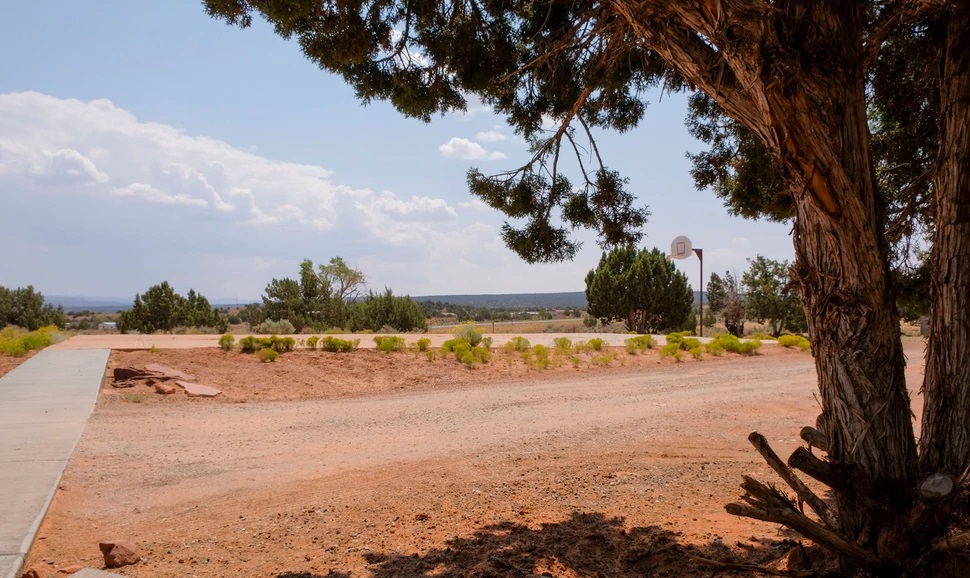
(Leah Hogsten | The Salt Lake Tribune) The basketball court outside the Navajo Mountain Clinic also serves as a helipad to transport patients in critical condition, Aug., 25, 2020. The Navajo Mountain UNHS clinic serves roughly 500 people in the Navajo Mountain tribal chapter and is run by a staff of Diné women.
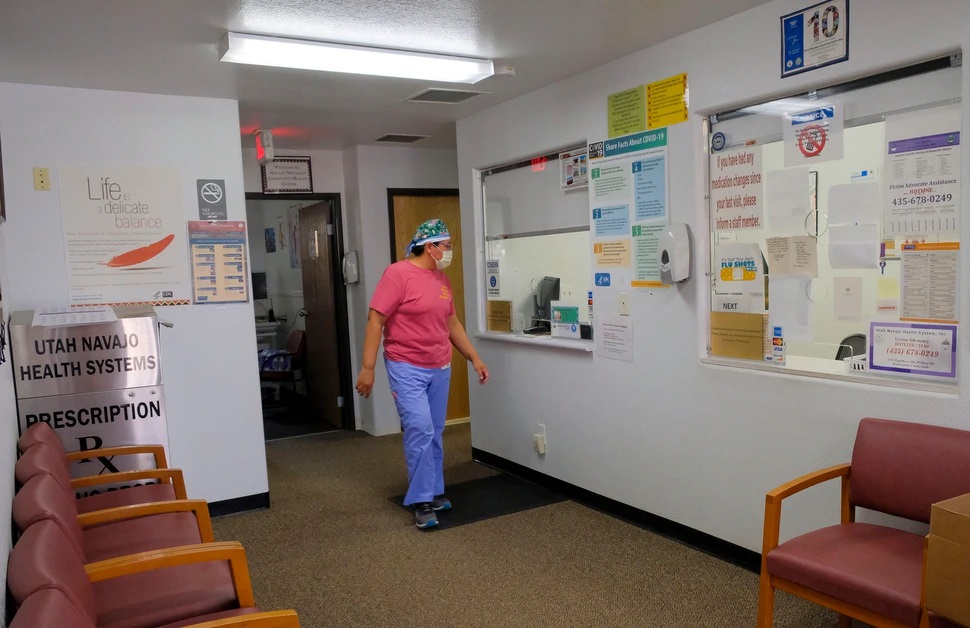
(Leah Hogsten | The Salt Lake Tribune) Navajo Mountain Clinic Manager Revina Talker walks through the clinic’s waiting area now closed to patients, Aug., 25, 2020. “We can’t let our guard down,” said Talker of the clinic’s response to the pandemic in the small community as flu season and fall approach. “I think we’re going to have to get ready for the next round.”
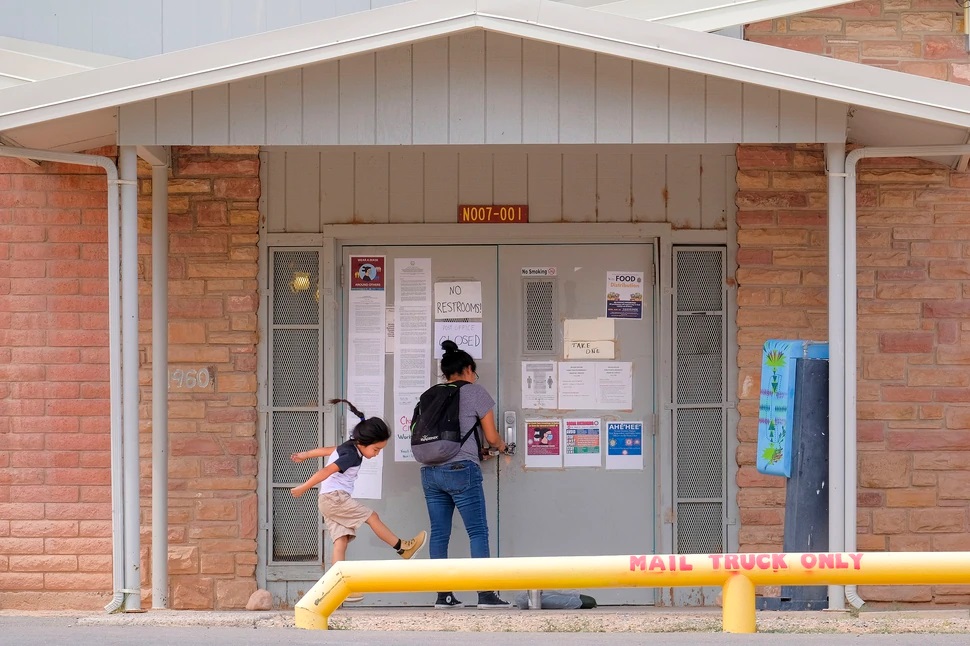
(Leah Hogsten | The Salt Lake Tribune) A Navajo Mountain Chapter House worker locks up after a food distribution drive, Aug., 25, 2020. Earlier this year, Navajo Mountain was one of Utah’s coronavirus hotspots.
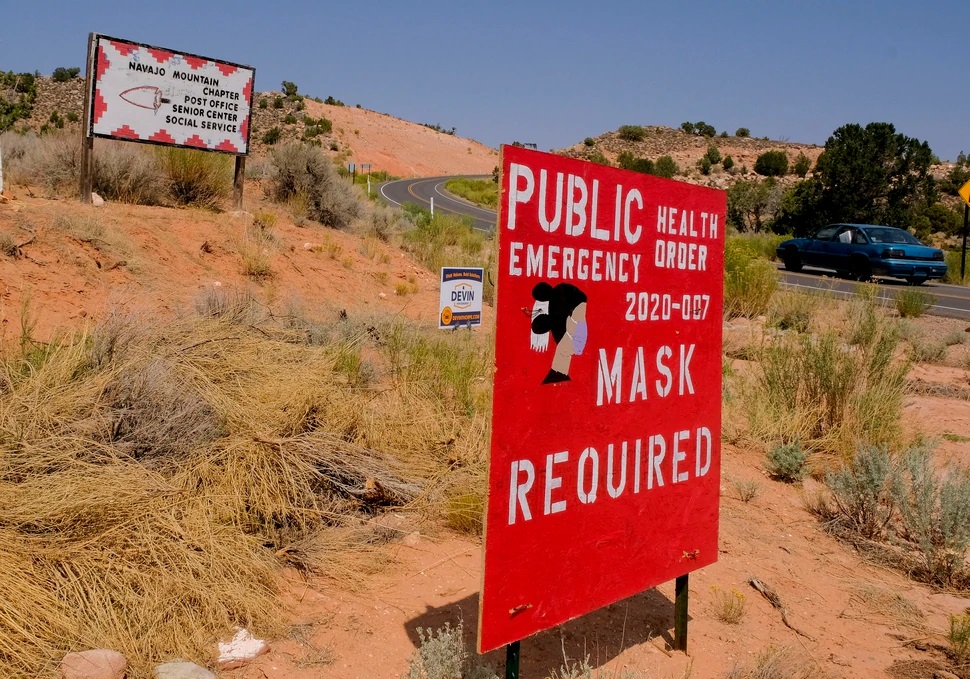
(Leah Hogsten | The Salt Lake Tribune) In March, the coronavirus came to the small community of Utah’s Navajo Mountain after residents attended a religious revival. Signs reminding residents and visitors that masks are required are posted throughout the town, Aug., 25, 2020. Much of the Navajo Nation has been closed since March after the coronavirus swept through the vast reservation that extends into New Mexico, Utah and Arizona.
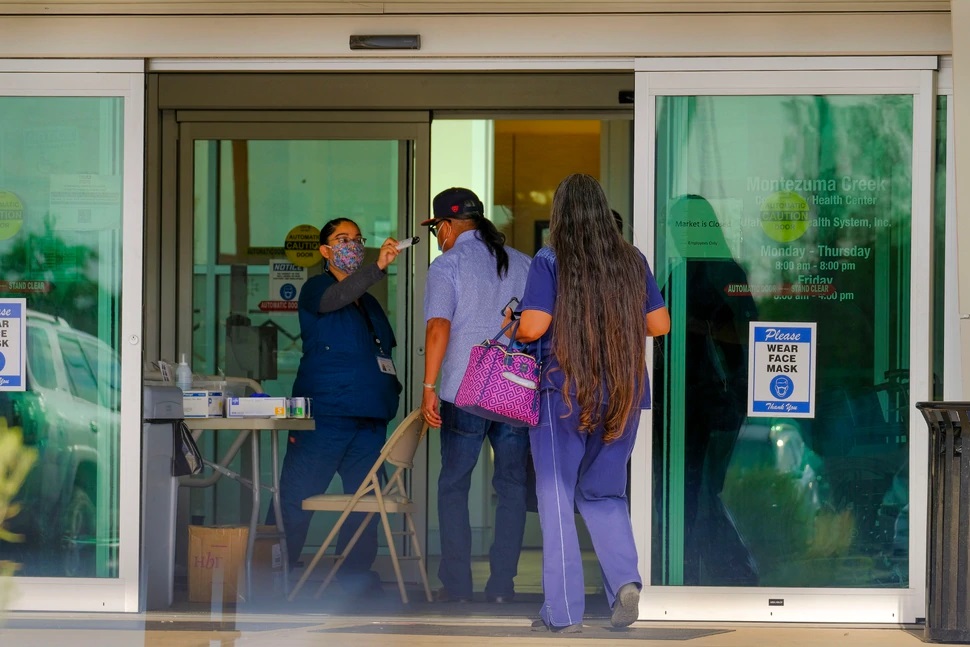
(Leah Hogsten | The Salt Lake Tribune) Visitors entering Montezuma Creek Community Health Center are screened for possible COVID-19 symptoms with a temperature check, June 24, 2020. The Montezuma Creek clinic is one of three other Utah Navajo Health System clinics in San Juan County.
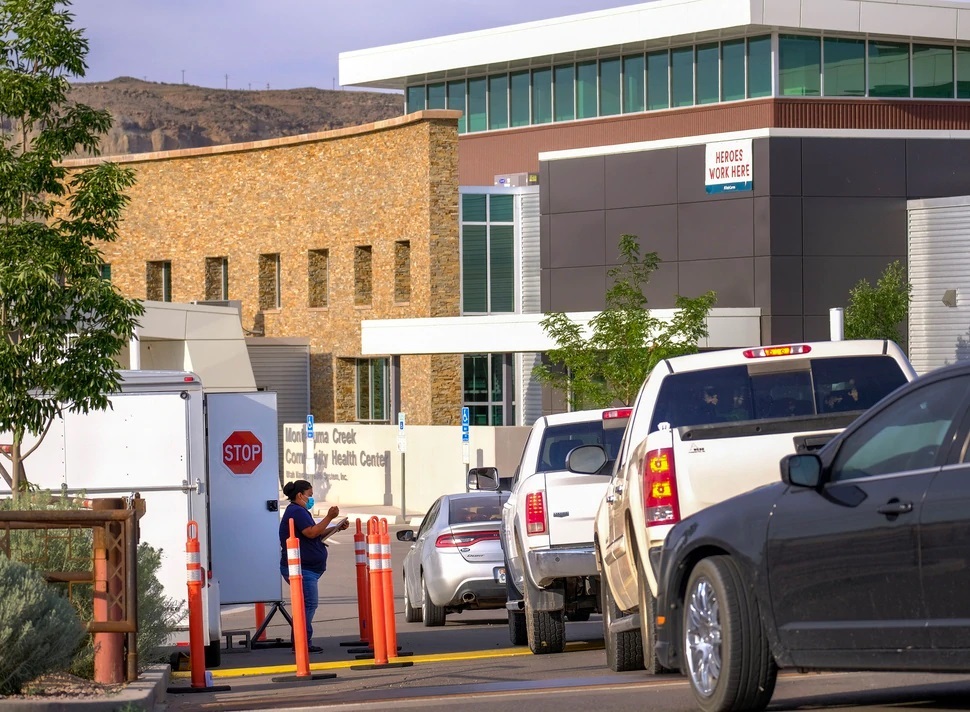
(Leah Hogsten | The Salt Lake Tribune) Visitors entering Montezuma Creek Community Health Center are met by a security guard that screens and directs visitors where they need to go, June 24, 2020. The Montezuma Creek clinic is one of three other Utah Navajo Health System clinics in San Juan County.
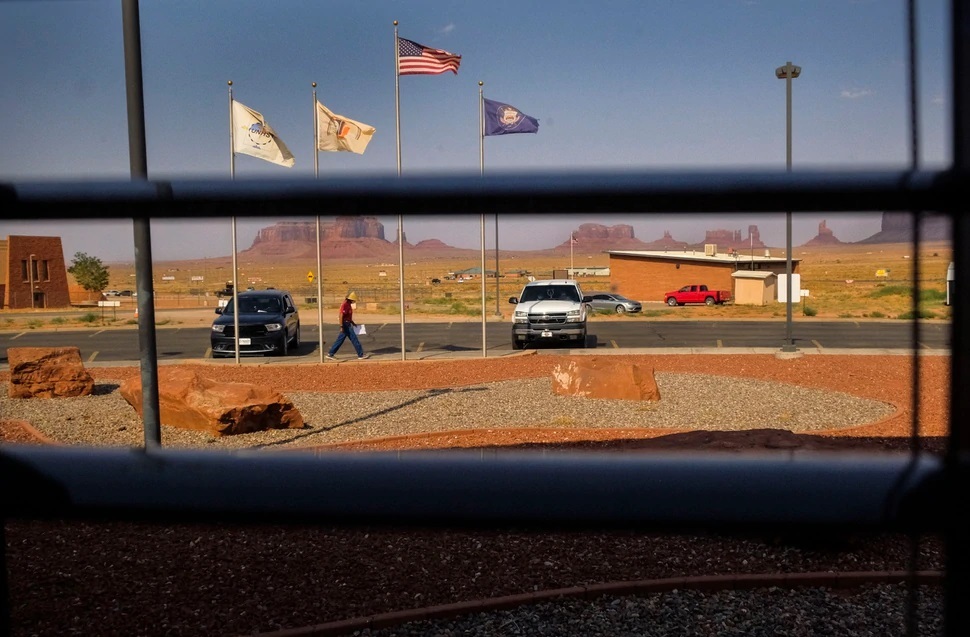
(Leah Hogsten | The Salt Lake Tribune) Monument Valley Health Clinic pharmacy runner Delbert Dixon, above in red, hustles in and out of the building, delivering medications to patients sitting in their cars Aug., 24, 2020. Like the three other Utah Navajo Health System clinics in San Juan County, patients are required to remain in their car whether they have an appointment with the doctor or are there to pick up prescription refills.
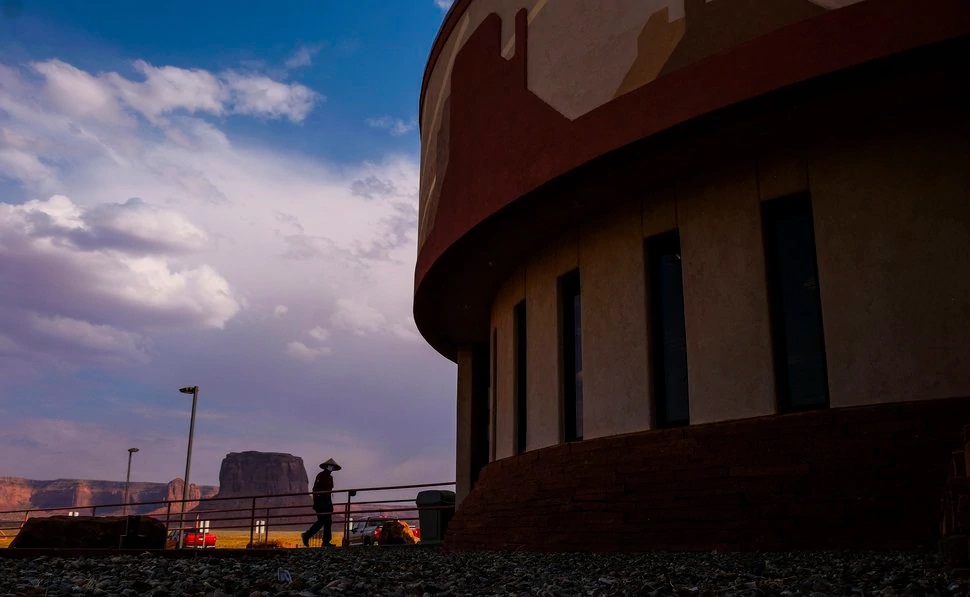
(Leah Hogsten | The Salt Lake Tribune) Monument Valley Health Clinic pharmacy runner Delbert Dixon, above in red, hustles in and out of the building, delivering medications to patients sitting in their cars Aug., 24, 2020. Like the three other Utah Navajo Health System clinics in San Juan County, patients are required to remain in their car whether they have an appointment with the doctor or are there to pick up prescription refills.
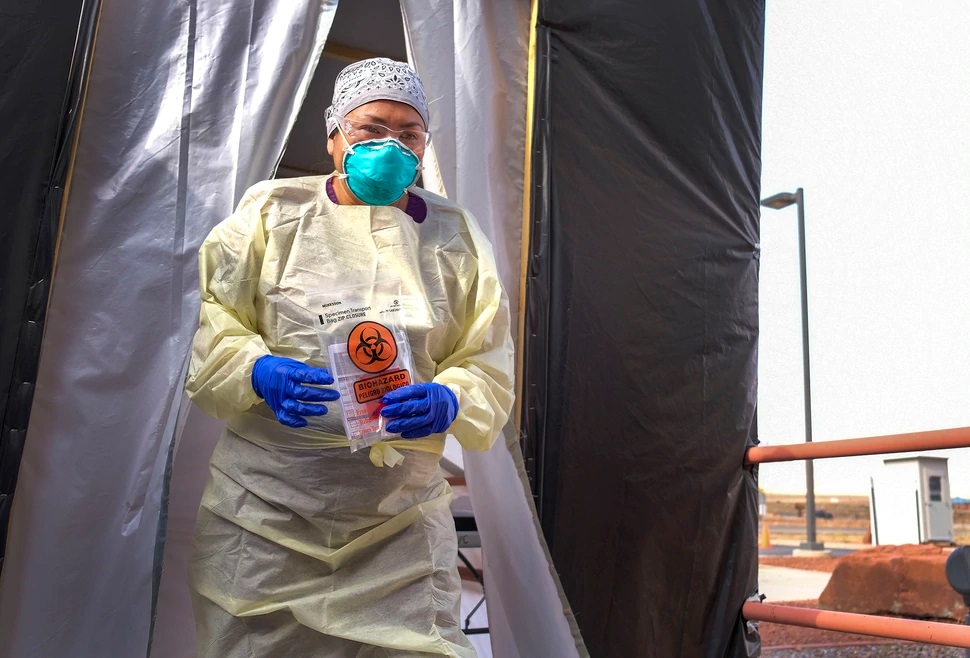
(Leah Hogsten | The Salt Lake Tribune) Shelly Begay, a Diné medical assistants at Utah Navajo Health System’s Monument Valley Clinic, carries a patient’s coronavirus test kit out of the mobile triage unit for transport and testing, Aug., 24, 2020. At the height of the pandemic, the clinic was conducting up to 60 coronavirus tests per day, but that number has fallen to between 5 and 10 more recently.
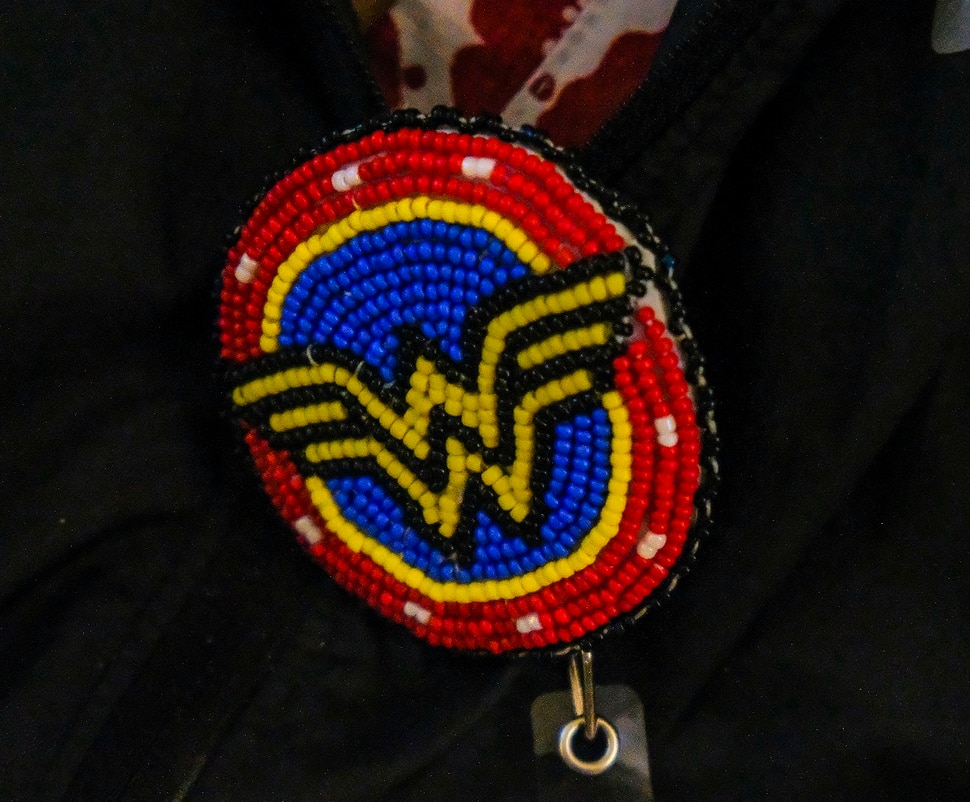
(Leah Hogsten | The Salt Lake Tribune) Brenda Vijil, a Diné medical assistant at Utah Navajo Health System’s Monument Valley Clinic, sports a hand-beaded Wonder Woman emblem on her identification lanyard, Aug., 24, 2020.
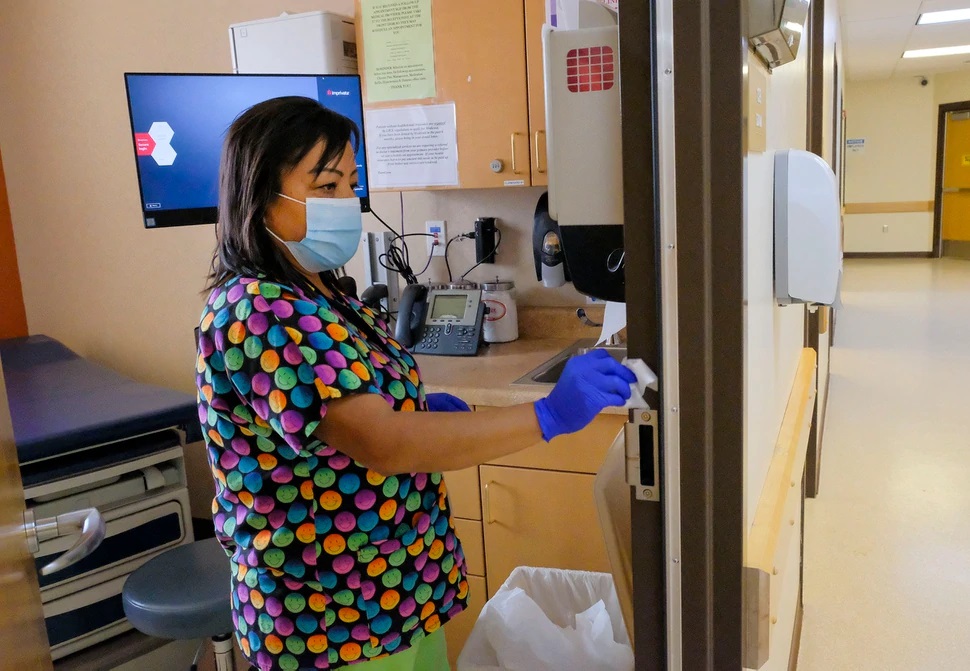
(Leah Hogsten | The Salt Lake Tribune) Monument Valley Health Clinic nurse Ernestine Harrison disinfects and wipes down the clinic’s treatment rooms, Aug., 24, 2020. Like the three other Utah Navajo Health System clinics in San Juan County, very few patients are admitted into the building for treatment. Most patients are required to remain in their car whether they have an appointment with the doctor or picking up prescription refills.
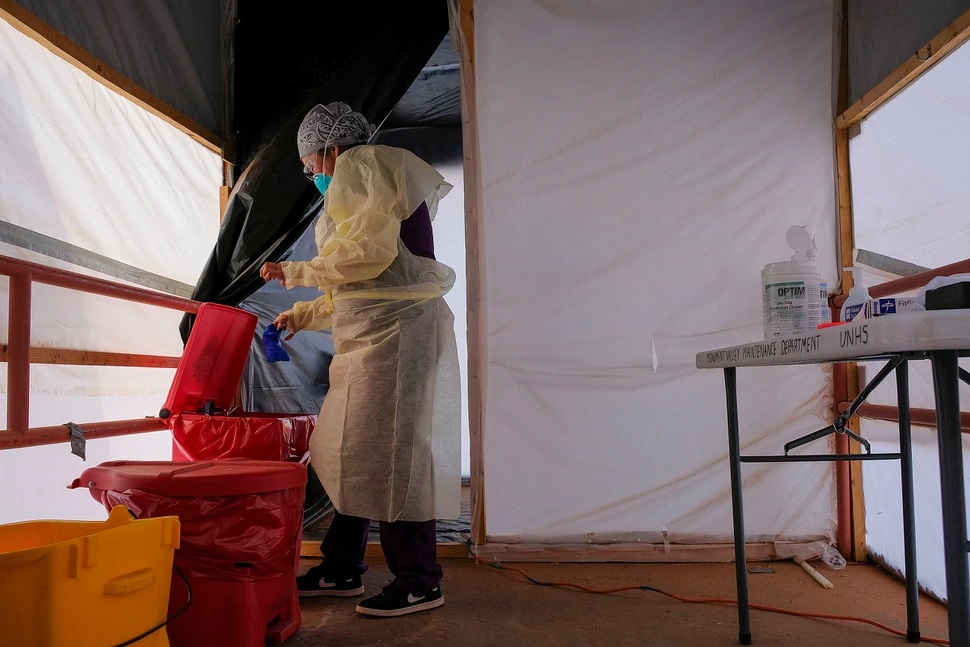
(Leah Hogsten | The Salt Lake Tribune) Shelly Begay, a Diné medical assistants at Utah Navajo Health System’s Monument Valley Clinic, strips off her gloves and gown in the mobile triage unit’s decontamination area after administering a coronavirus test to a patient. Aug., 24, 2020.
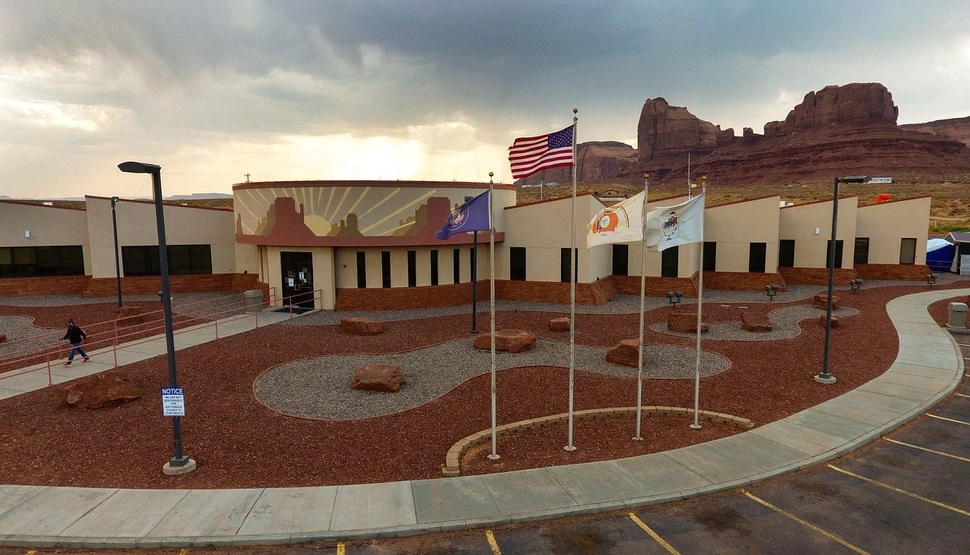
(Leah Hogsten | The Salt Lake Tribune) Utah Navajo Health System’s Monument Valley Clinic, Aug., 24, 2020. Like the three other Utah Navajo Health System clinics in San Juan County, patients are required to remain in their car whether they have an appointment with the doctor or are there to pick up prescription refills.
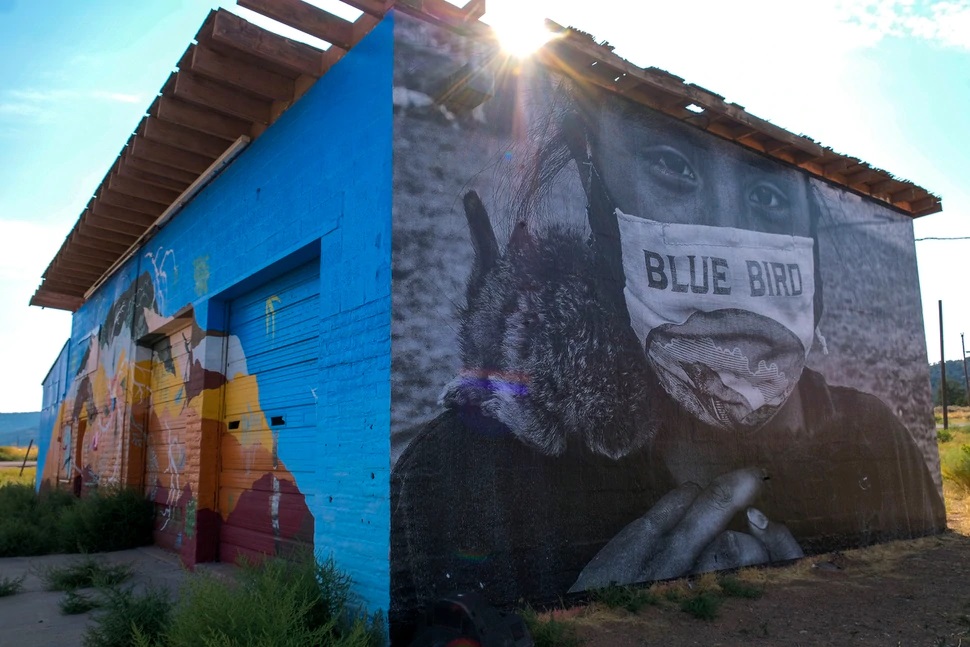
(Leah Hogsten | The Salt Lake Tribune) A mural by street artist jetsonorama, dated June 7, 2020 to Aug. 9, 2020, on the Navajo Nation west of Kayenta, Arizona, Aug., 25, 2020.
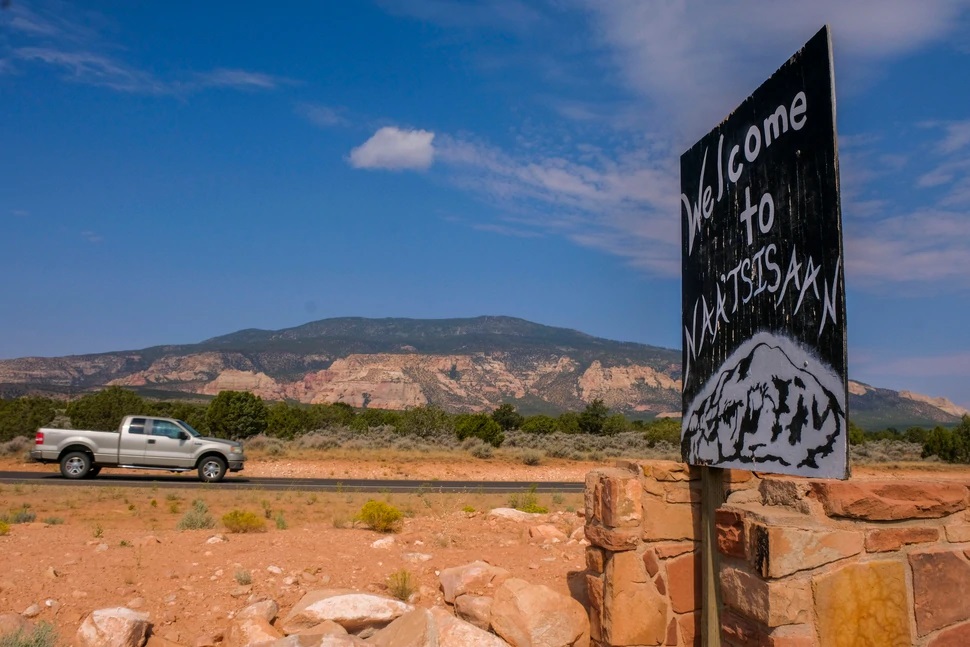
(Leah Hogsten | The Salt Lake Tribune) Nestled between its namesake mountain and Lake Powell, the community of Navajo Mountain or Naatsisʼáán meaning “Head of the Earth Woman has cultural significance for three Native American tribes, Aug., 25, 2020.
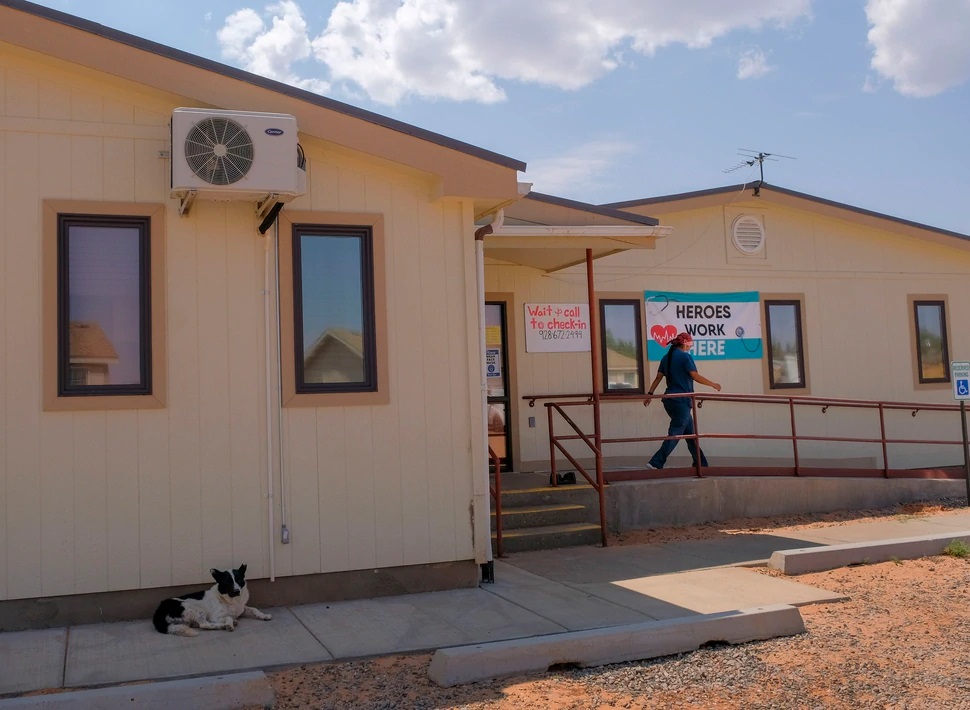
(Leah Hogsten | The Salt Lake Tribune) “I love working here,” said Navajo Mountain Clinic medical assistant Sonya Sloan, above, heading out to grab something from her car Aug., 25, 2020. “I love helping my people.” The Navajo Mountain UNHS clinic had to close down in June for two weeks after a staff member tested positive for COVID-19. The clinic currently serves dental patients one at a time and patients who need urgent medical care or coronavirus testing. Staff members deliver medications to patients in their vehicles.
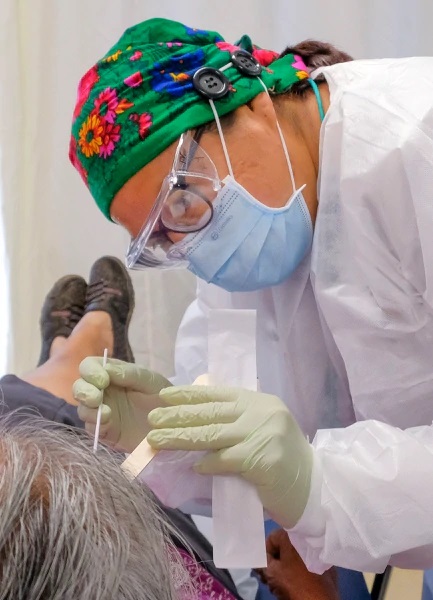
(Leah Hogsten | The Salt Lake Tribune) Navajo Mountain Health Clinic medical assistant Toni Black suits up in personal protective equipment or PPE, while tending to a 74-year-old Diné patient, Aug., 25, 2020. Black is extra cautious and now wears three layers of latex gloves since the UNHS clinic had to close down in June for two weeks after a staff member tested positive for COVID-19.
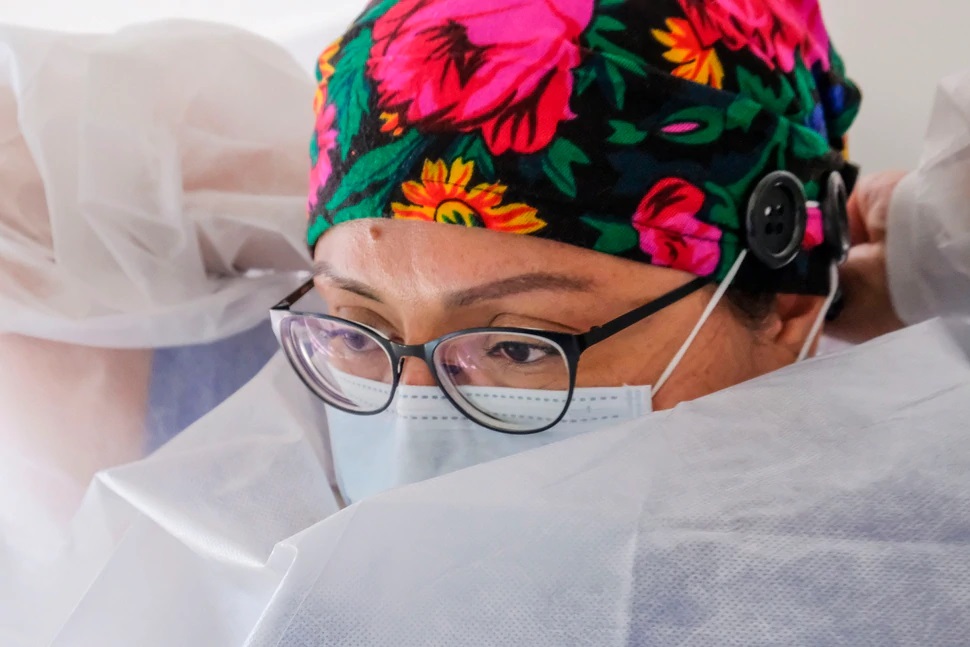
(Leah Hogsten | The Salt Lake Tribune) Navajo Mountain Health Clinic medical assistant Toni Black suits up in personal protective equipment or PPE, while tending to a 74-year-old Diné patient, Aug., 25, 2020. Black is extra cautious and now wears three layers of latex gloves since the UNHS clinic had to close down in June for two weeks after a staff member tested positive for COVID-19.
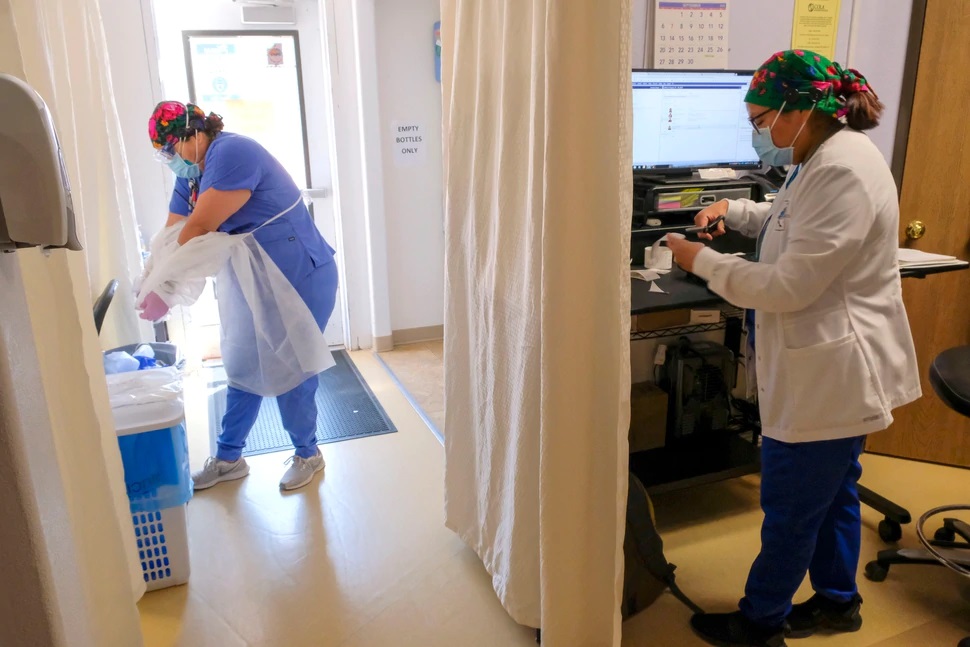
(Leah Hogsten | The Salt Lake Tribune) Navajo Mountain Health Clinic medical assistant Toni Black strips off her personal protective equipment, left, as lab technician Roxanna Yazzie tests bloodwork from a 74-year-old Diné patient, Aug., 25, 2020. Yazzie is one of ten staff members responsible for driving coronavirus tests from Utah’s Navajo Mountain to the San Juan County Public Health building in Blanding, a 185 mile trip one-way.
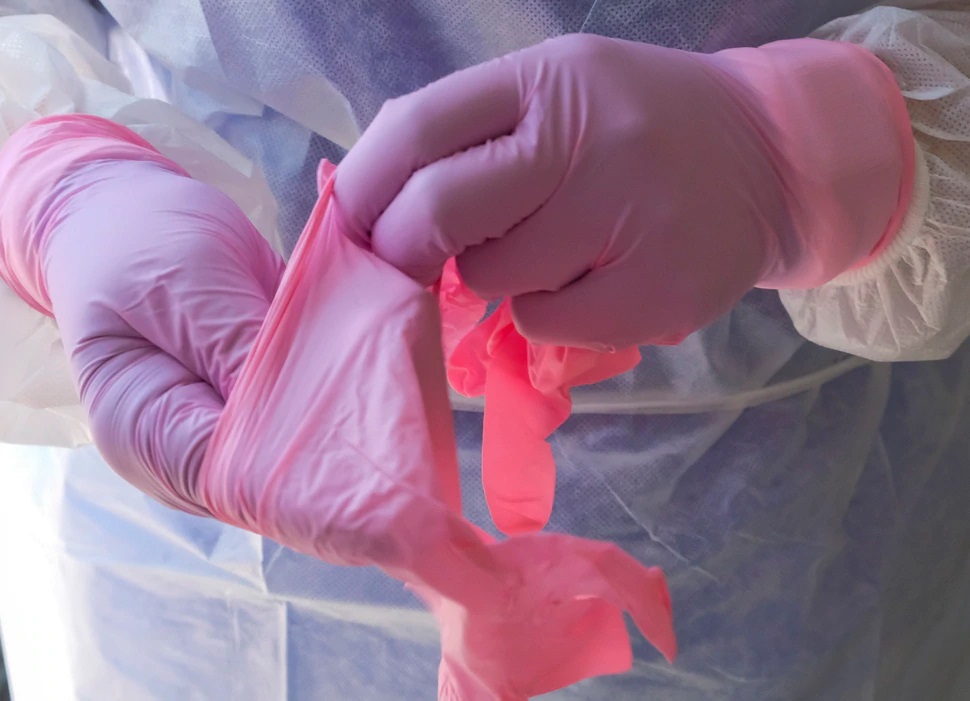
(Leah Hogsten | The Salt Lake Tribune) Navajo Mountain Health Clinic medical assistant Toni Black suits up in personal protective equipment or PPE, while tending to a patient, Aug., 25, 2020. Black is extra cautious and now wears three layers of latex gloves since the UNHS clinic had to close down in June for two weeks after a staff member tested positive for COVID-19.
A security guard meets the patients at the entrance and will screen them for symptoms of COVID-19 before placing a color-coded placard on their windshield, indicating whether they have an appointment with a doctor or are there to refill prescriptions. Unlike other pharmacies in the county, Monument Valley is not set up as a drive-thru, so a runner spends the day relaying medications from the pharmacy lobby to patients’ cars.
Patients come into the building only when necessary, and high-risk health care workers have found ways to isolate themselves. Begay, for example, works with Dr. Phillip Smith, a practitioner in his 70s who has been meeting patients via teleconference since March.
If Smith decides a patient needs a wound bandaged or an injection administered, Begay will go out to the person’s car and take care of the issue. When patients need to come inside for an X-ray or other treatment, they have their temperature taken at the door to ensure they don’t have a fever, a potential sign of a coronavirus infection.
Patients exhibiting symptoms of the disease are directed to a separate parking area, where they are tested in a white tent area outside a back entrance to the clinic. So far the system is working. Despite treating hundreds of COVID-positive patients, Monument Valley staffers have remained coronavirus-free.
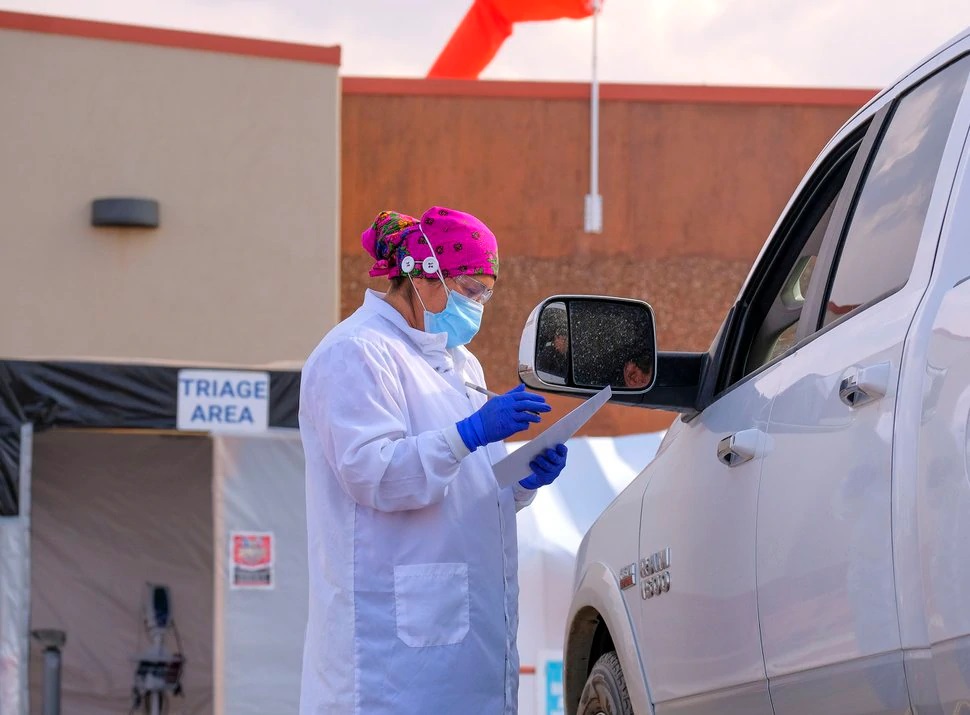
Brenda Vijil and Shelly Begay, both Diné medical assistants in their early 30s, often work together to test patients at the COVID entrance, a process that can take up to half an hour per patient for screening and swabbing.
Every time Vijil or Begay leaves the tent and reenters the building, which is necessary between every patient, she disposes of her thin plastic gown, changes gloves and washes her hands.
“We usually help each other a lot,” Shelly Begay said, adding that it’s much more difficult when there is only one person running the tent.
At the height of the pandemic, the clinic was conducting up to 60 coronavirus tests per day, but that number has fallen to between five and 10 more recently.
Although there are fears that there could be a resurgence of the coronavirus in the fall, Vijil said the staff is much better prepared now compared to last spring.
Vijil is the oldest of eight siblings and she was staying in a single room with her two children on her parents’ land when the pandemic began, an off-grid homesite in Monument Valley. The house relied on solar panels and, like over 40% of the Navajo Nation homes in San Juan County, required water to be hauled in from a public spigot, factors that required extra precautions when transitioning between the clinic and home life.
Vijil would bring a clean set of clothes into work with her and shower at the clinic before going home. During her free time, she volunteers as an ambulance driver, and she’d often have to suit up again at night to go out on a call, especially at the peak of the outbreak. Her mother prepared traditional sage and juniper tea to keep her healthy, and Vijil and her family never caught the coronavirus.
She has since rented a house in nearby Kayenta, Ariz., which she said is a better option for keeping herself and her family safe. “It all changed ever since I got my own place,” she said, “because I have running water and electricity there.”
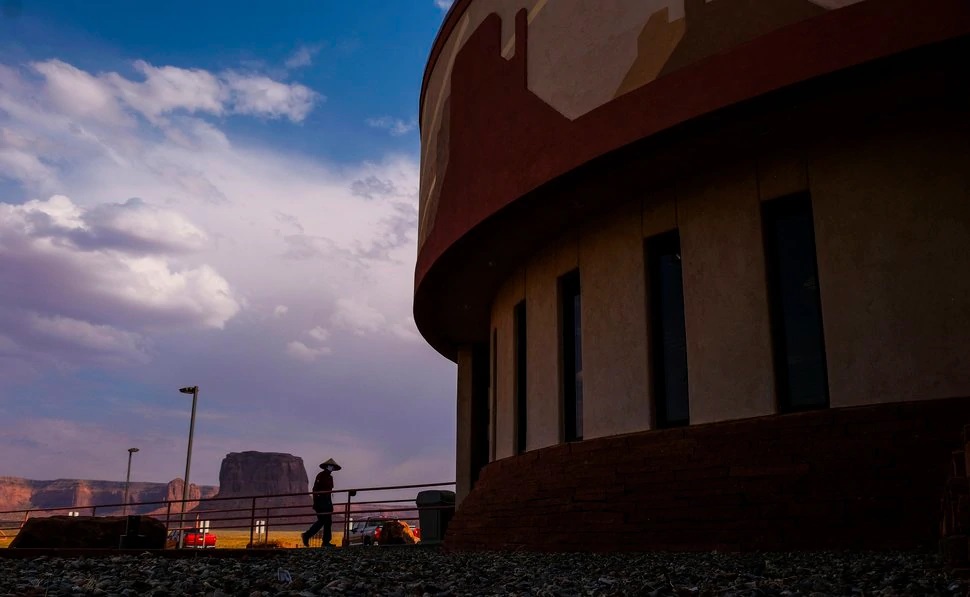
Donations and preparations
If the tightly knit communities on the northern Navajo Nation made the residents more susceptible to the pandemic early on, those ties have also been essential in providing quality care to rural areas, improving contact tracing and making sure isolated elders have resources they need. UNHS set up a fundraising and food distribution arm to deliver goods to families quarantined at home.
Talker, the clinic manager in Navajo Mountain, said donations for the clinic and for the home delivery program poured in from around the country after a May article came out in the Navajo Times by reporter Krista Allen profiling the women who work at the remote clinic.
“We try to make sure that the people we know here who don’t have vehicles, running water or electricity — they take priority as far as getting food, water,” Talker said. “I rely on the staff to help me with that. We made a list of families, and then once we get the donations, [the staff] make the deliveries.”
After a rough spring and early summer, pandemic safeguards are becoming incorporated into everyday routines and case counts are plummeting. On Sept. 9, the Navajo Nation reported no new coronavirus cases, a first since the initial case was identified in mid-March. But Talker said she’s not planning to let her guard down.
“Things are calming down,” she said, “but we’re getting ready in case there’s a next round.”
Zak Podmore is a Report for America corps member and writes about conflict and change in San Juan County for The Salt Lake Tribune. Your donation to match our RFA grant helps keep him writing stories like this one; please consider making a tax-deductible gift of any amount today by clicking here.
